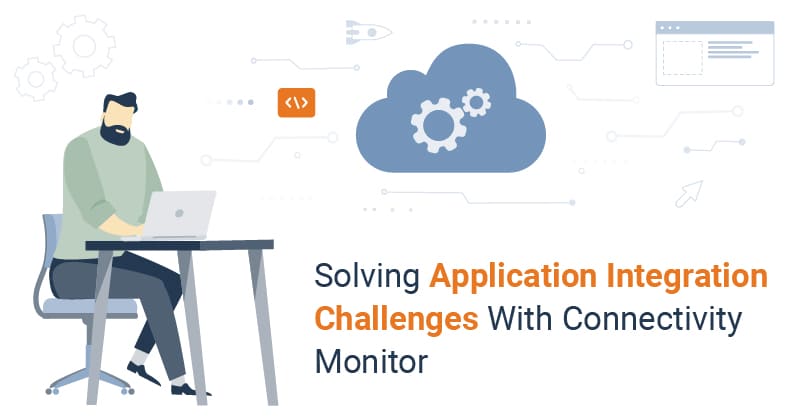Top 5 Application Integration Challenges Data Integration Solution Can Help You Solve
 Khalil Bouzidi
Khalil Bouzidi
Table of contents
Organizations are increasingly investing in function-specific applications to strengthen their business functions. There was a time when enterprises relied on their ERP to do it all. With the boom of applications, organizations are looking for the best applications for customer relationship management, logistics, and so on. So, while organizations use a multitude of disparate niche applications to manage business functions, their application ecosystem is getting more complex.
A centralized integration platform such as Data Integration Solution for Microsoft Dynamics 365 F&SCM connects all these applications to the ERP to streamline processes and synchronize data across systems. However, what most organizations tend to undermine is integration monitoring. Once the one-time integration setup has been implemented, monitoring and ensuring apps are healthy is crucial and if not done could cause operational delays, data synchronization problems, and other issues.
In our conversations with customers of Data Integration Solution, we often hear that post-implementation, they feel the need to manage and assess the impact of integration failures and that can be time-consuming. Based on this customer feedback, we realized that they could use a tool to monitor integrations so that they could minimize the impact of integration failures on business processes.
In order to address those challenges, we built an application integration tracking app within the solution to monitor your integrations in D365 F&SCM. In this blog, we share the challenges in application integration monitoring that our customers faced prior to using Data Integration Solution. This blog will also help you understand how crucial it is to monitor integrations as it explains the challenges organizations face without a software to help them monitor how their integrations are performing.
Challenges with application integration monitoring
Unless you proactively manage and monitor your integrations, you cannot easily troubleshoot integration failures. Let’s go through the integration challenges below.
1. Losses incurred due to mean time to repair
When integrations are down, unless you have set up an alert, it could take some time to realize that the integration is even broken. Then you will need to alert the responsible teams to get the integrations back up. In the meantime, there could be operational or other issues due to this. For example, according to AppDynamics, 7 hours of mean time to repair (MTTR) could cost organizations about $402,542. So, the longer the integration is down, the higher the cost could be for the organization.
Data Integration Solution's monitoring app, on the other hand, has been embedded within Microsoft Teams for seamless collaboration. So, when there is an error or an integration failure, a notification is issued in Teams. You can use the message log feature within the app and easily navigate to failed integrations with the failure URL. This app makes it easier to monitor failed integrations, find a quick resolution, and reduce your MTTR.
2. Lack of visibility into integration health
When you have no visibility into integration health, for example, if some integrations are slow or lagging and causing unnecessary delays then that will impact business processes. It is difficult to monitor the health status of your integrations unless you have a solution for the same.
lagging and causing unnecessary delays then that will impact business processes. It is difficult to monitor the health status of your integrations unless you have a solution for the same.
For example, if you are working with a third-party logistics (3PL) and you promised a delivery date to the customer and the order has not been sent to the 3PL warehouse. This is not updated in your system due to an integration failure. If you miss the deadline and do not send out a notification to your customer, then you have an unhappy customer.
The integration monitoring dashboard in Data Integration Solution shows you the overall integration health. Additionally, in case you want to investigate ahead of a failure, the app gives you a view of the top 10 slow-performing integrations and integrations with partial errors.
3. Long time to deep-dive to identify the root cause of the issue
When an integration breaks and if you do not have our integration monitoring app, it is difficult to understand what went wrong. By the time the IT team investigates and pinpoints the root cause of the issue, assesses the damage, and deploys a fix, by then some of your business processes will have been impacted.
The Power BI dashboard provided by our monitoring app lets you slice and dice data by impacted companies and applications and also shows you a log of the impacted records from failed integrations.
4. Lack of intelligent levers to help optimize integrations for better
You go about integrating all your business processes including logistics and with time some integrations can start lagging or even fail. If you had some kind of business intelligence dashboard that gave you access to strategic metrics such as slow-performing integrations, error-prone messages, and other metrics, you could stay on top of your integrated applications and the data flowing between your systems and avoid any operational issues due to an integration failure.
5. Difficult to showcase key metrics
When the IT team showcases key metrics using an application integration interface to business users they often find it hard to explain. However, our integration monitoring app is a simple-to-use tool that can be used on mobile phones or tablets and provides the key metrics that will help project managers and other business users keep track of connected applications and any potential issues that they foresee.
Are you looking for a solution to solve these challenges?
If you are facing operational delays, unoptimized business processes, and errors and are unable to monitor your application integrations, then it is time to look for a solution. While you might be able to work on a solution in-house if you have the technical expertise but that will need a lot of resources, expertise, and cost. Alternatively, you could invest in an enterprise-ready integration solution with a monitoring feature or application that can help you mitigate these challenges.
If you are a Microsoft Dynamics user then, you could explore our no-code Data Integration Solution for Microsoft Dynamics 365 for F&SCM that has been built within the D365 environment. This advanced platform is a mapping solution that has helped 500+ customers smoothly transfer data in and out of Dynamics 365 F&SCM. The solution's integration monitoring app, which has been built with Dataverse as a foundation with Power Apps and Power BI as the front end, will help you track the health of your integrated applications as well.
If you are keen to learn more about how our solution facilitates seamless unlimited integrations and helps you monitor integration performance in real-time, download our solution factsheet from the link given below.

